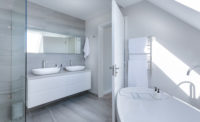Jeff Valles: Foot traffic
Do customers need to visit your showroom to make specification?

Now that I am back on the manufacturing side of the game, I am reminded how important catalogs are to working with the design trade. The old adage that people need to see an elegant faucet in order to appreciate it and to specify it has evolved into a myth wrapped up into a ribbon of hope.
Talented designers and architectural design teams do not need to see the faucets, showers and tubs they are specifying. They absolutely do need to visit a top-line, forward-acting showroom from time to time to see what is new and trendy. But, they do not need to visit a showroom every time they design a bathroom or kitchen — it simply is not necessary nor worth the time. If they know the manufacturer crafts a quality product and it can be sourced from a knowledgeable and service-oriented distributor, the design trades are comfortable writing their specification from their desk based on the information from a catalog and/or the internet. By the way, this is not new behavior; catalogs have been specification references since I joined this industry in 1979 and their reach has continued to expand over the decades.
Retail product catalogs have been around since the late 1400s. In the late 1800s, as printing costs dropped, catalogs began to expand their reach. They really hit their stride when Sears and Roebuck sent out catalogs to every corner of the United States. Catalogs are in our purchasing DNA. We have been learning about and purchasing just about every type of product from catalogs for more than 150 years. If you think they are not effective today, think RH. Yes, it has now discontinued its huge catalog, but the huge season catalogs were a key part in building brand awareness and driving customers, designers and engaged homeowners to its showrooms. Wouldn’t you like your brand to be as strong in your market as the RH brand?
Some decorative history
In the early years of decorative plumbing and showrooms, designers and architects were still in the process of discovering what a decorative faucet was. In the 1970s, decorative plumbing was a new product category. Before then, there was Sheryl Wagner’s showroom on 59th street in Manhattan and the two leading brands, Artistic Brass and Phylrich International. There were only a handful of showrooms and only a few of those were truly successful on their own.
At that time, products were quirky. Finishes had 90-day warranties, at best, and the fit and finish was inconsistent. This led to some plumbers and contractors absolutely refusing to purchase and install these pretty faucets. Even with this backlash, the category continued to grow. This was a volatile time in our industry. And with all this going on, decorative showrooms became the go-to place for progressive architects, designers, builders and plumbers to learn what was working and which brands to trust.
In the mid 1980s, the existing brands expanded their product offerings and new designer plumbing companies began to enter the market. The industry’s growth allowed decorative manufacturers to implement better processes and purchase better performing valving systems. This added volume and accompanying efficiencies increased profits. Manufacturers invested that extra cash into testing and implementing new technologies to make their products more durable and shine brighter.
When we entered the 21st century, decorative plumbing products were pretty bulletproof. Although certain installation and communication issues remained, most people and professionals realized that premium and luxury homes, hotels and offices would have elegantly appointed bathrooms. Gone was the day of having to install a simple polished chrome four-inch center-set because it worked. Today, consumers, design professionals and developers trust decorative products and have their favorite go-to brands.
With that trust, the role of the decorative plumbing showroom has become less about what products will work and last. Today, showrooms gain attention by becoming the source for what is new, what is trending and what works best in a certain style. The same questions that fabric, furniture and flooring showrooms have been answering for decades. Day-to-day product knowledge are table stakes.
In 2020, the design and building trades do not need to visit a decorative plumbing showroom for each job specification. Catalogs and the internet coupled with decorative manufacturer’s talented customer service departments and knowledgeable showroom consultants offer more than enough information to help professionals get each individual product application correct while sitting at their desk.
From the 1970s though most of the 1990s, decorative plumbing showrooms' main function was to present, educate and support those attempting to design, build and live, work and visit beautiful spaces complimented by dynamic-looking and functioning plumbing fixtures. Today’s showrooms still need to present, educate and support the design and building trades along with the homeowner but not in the manner.
Some simple guidelines
Present: Show new products, new applications, new finishes and new brands. Make your vignettes outrageous and easily remembered. It is all about what is new, different and memorable.
Educate: Keep the design and building trades up-to-date on what is new along with changes in the industry. Make sure they know what you are doing. Share your work; it will remind them that you are not only a good source of information, you are good at what you do. A showroom must no longer simply guide its clients to what functions consistently and will hold up over time.
Support: This has not changed, in fact it has expanded. Great customer service and all stages of the process is a necessity.
A final thought
As digital and printed catalogs are constantly being sent, and the internet continues to grow and improve coupled with digital savvy generations becoming the majority of our target market, we need to not only gear our brick and mortar showrooms for excitement and flexibility, we must develop the same presence for our decorative showroom brands on the internet. Today, the go-to internet sites for designers, builders, plumbers and homeowners are your individual brand websites. In 2021, the leading decorative faucet manufacturing brands have recognizable names. They have built internet sites that are comfortable to use to make a specification, price a job and direct customers to a myriad of distributors, both digital and brick and mortar, to make the purchase. If they continue to grow with no local, unique multi-line decorative plumbing websites, the brands, not the showrooms, will dictate many one brand job specifications. This will force many decorative plumbing showrooms into simply competing on price to win digitally created quotes.
This is a great time to be in the decorative plumbing business, there are many opportunities and venues to tell your unique story. But we must not forget a mature, profitable and expanding market while full of opportunity will also attract new players and more capital. Your brand has its success story, and if shared aggressively and intelligently, will enjoy a fabulous 21st century roaring 20s.
It is better to be a brand thought of as a source of information, product and support versus one of many vendors which simply sources products, delivers and supports popular brands.
Looking for a reprint of this article?
From high-res PDFs to custom plaques, order your copy today!





